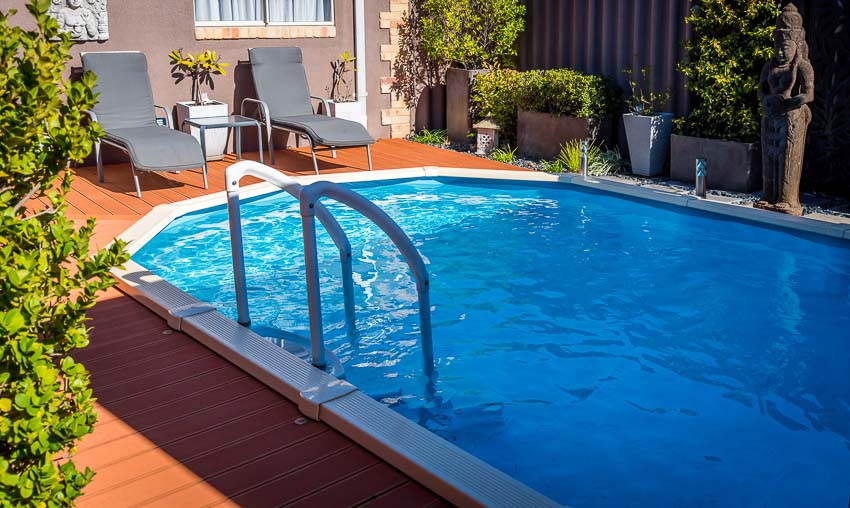Is your above ground pool awkward and out of place? The right landscaping around an above ground pool transforms its appearance, making it an integral part of your backyard oasis. In this guide, you’ll find the best ideas and tips for landscaping around your pool.
Benefits of Landscaping Around an Above Ground Pool
Above ground pools are affordable and easy to install and maintain, but on the downside, they can stick out like a sore thumb in your landscape. With the right techniques, you can enhance the aesthetics and turn your poolside landscape into an outdoor haven.
Enhancing Aesthetics and Ambiance
Landscaping around a pool creates cohesion between your landscape and pool, enhancing the appearance and setting a tone for your outdoor pool area.
With the right plants and landscaping features, you can make your pool an attractive focal point in your yard. What’s more, you can transform it from an unpleasant eyesore to an inviting recreational area.
Privacy and Visual Barrier
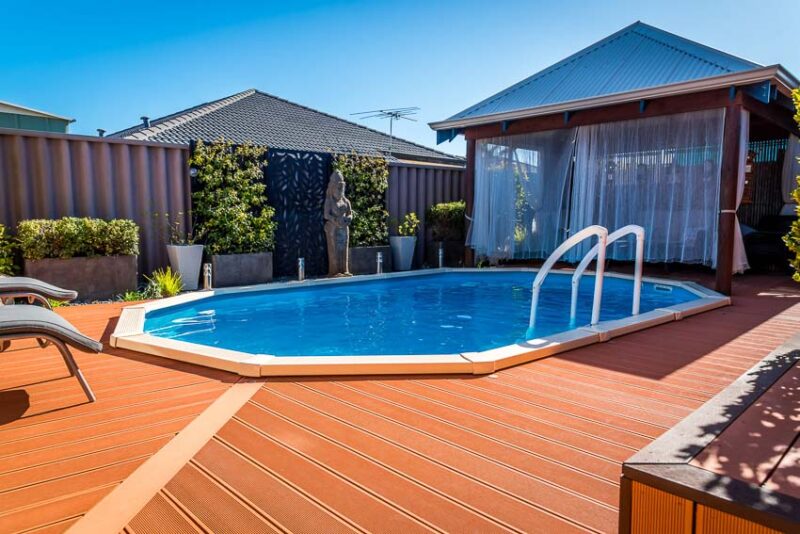
Plants and hardscaping features can obscure the sides of your above ground pool. And this will make it look like it’s a natural part of your landscape. Everything from decks to pathways can be used to surround the pool and make it more visually appealing.
Landscaping can also be used to make your outdoor pool area more private. Choose privacy fences, tall shrubs like arborvitae for hedges, or plant a living wall to make your pool area peaceful and private.
Once you have your hedges in place, you’ll need to maintain them. Be sure to explore our guide to hedge trimmers!
Safety and Functionality
Landscaping features around your above ground pool aren’t just for looks. They also make it safer and easier to use and maintain.
Whether you add a deck around all or part of the pool or use landscaping materials like river rocks and gravel, you can make your pool more enjoyable and comfortable. Planting shrubs around the pool’s exterior hides the sides of the pool from view and keeps people away from the supports.
If you choose wraparound decking for your above ground pool, many people won’t even know it’s not in the ground, and it’s easier to set up a fence to keep children and pets out of the pool. You can also add seating, lights, and steps for safety and functionality.
What to Include in Your Above Ground Pool Landscape
Landscaping around a pool is exciting and fun, but before you get started, select suitable plants and take some time to consider your options for hardscaping elements.
Choosing Suitable Plants
Different plant species have specific soil, light, and water requirements. Learn more about how to choose the best plants for poolside landscapes.
Sun and Shade Requirements
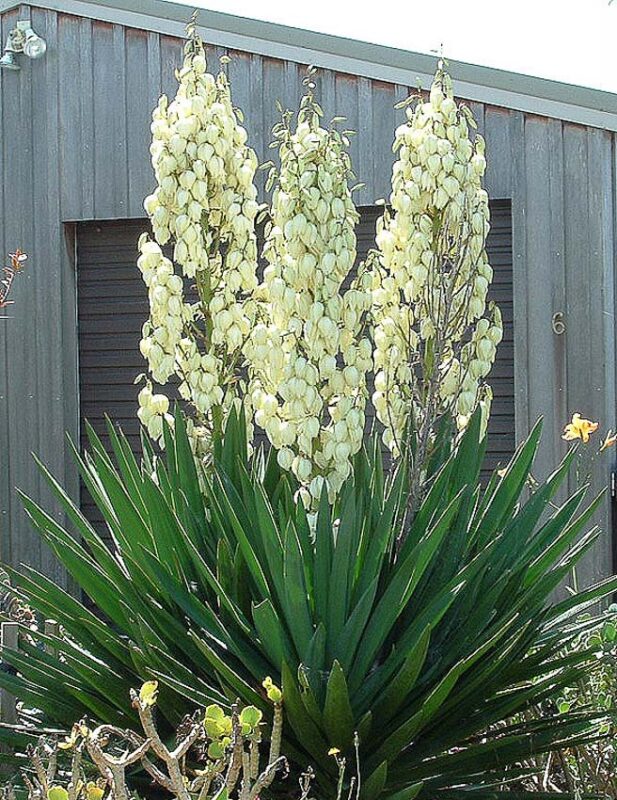
Pay attention to how much sun your pool area gets and find plants that grow best in those conditions. Most pools are in full sun, but the pool itself may provide shade for several hours, depending on what side of the pool it’s on.
For full sun in the afternoon, choose ornamental grasses, yucca, and succulents like sedum and Echevarria (hens and chicks). Evergreens like arborvitae and juniper will tolerate light shade, and shade ground cover such as hostas.
Soil and Root Needs
When it comes to planting around an above ground pool, it’s important to choose a plant that grows in your yard’s soil conditions without producing a large root system. You also need good drainage around your pool to prevent issues with standing water, which can suffocate plants.
A lot of what happens with a plant is below the ground, where we can’t see. Some develop extensive root systems. When you plant them near a swimming pool, their roots can cause bumps that pierce the lining.
Bumpy roots also make it impossible for a pool cleaning robot to operate because automatic pool cleaners require flat, smooth surfaces. You should also avoid trees or plants with abundant suckers, like many species of sumac and willow.
Some plants will grow in almost any soil type, while others require specific soil conditions. Choose a plant that will grow best in your soil, and if necessary, add soil amendments to change the pH. You can also add organic matter, such as peat moss or compost, to improve the soil when you plant.
Plants for Saltwater Pools
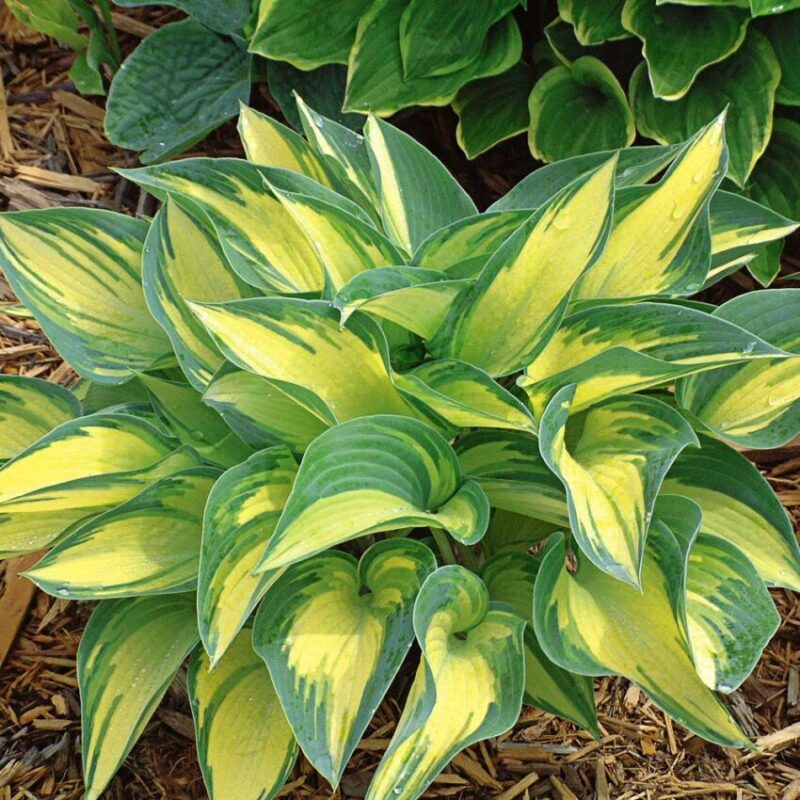
While many people worry about the salt or chemicals splashing on their plants, most plants can tolerate occasional soaks with pool water. If your soil has good drainage, the chemicals from pool water will leach through the soil and won’t harm your plants.
If you’re concerned about salt, here is a list of salt-tolerant plants to choose from:
- Bayberry (Myrica gale)
- Common juniper (Juniperus communis)
- Hosta (Hosta spp.)
- Blue fescue (Festuca spp.)
- Mugo pine (Pinus mugo)
- Rosemary (Salvia rosmarinus)
- Russian Sage (Salvia yangii)
- Sedum or stonecrop (Sedum spp.)
Other Considerations
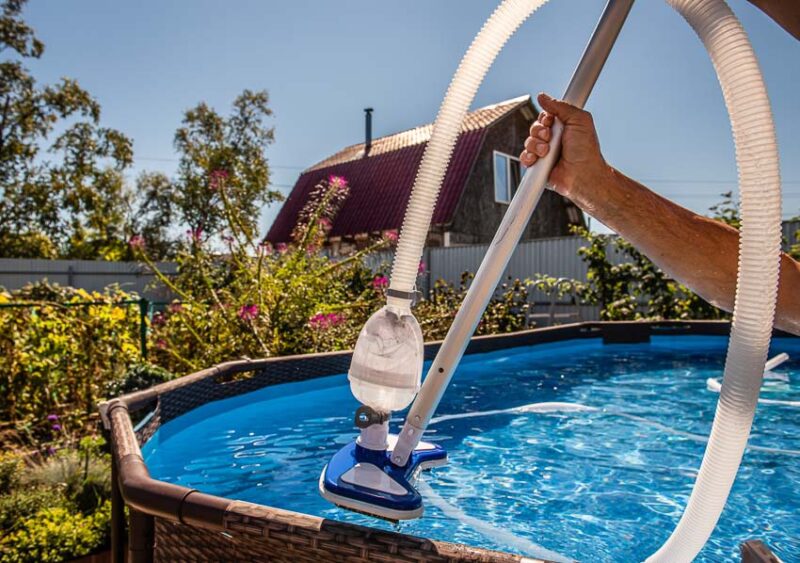
It’s helpful to leave a “no grow zone” around the base of your pool so that you can access the sides of your pool for maintenance. Ideally, a plant will camouflage the pool, but for safety reasons, you want to keep them low enough that you can still see the entire surface.
Evergreens are an excellent choice for planting around pools because they are less messy than deciduous trees. It’s best to avoid tall trees that shed needles and leaves you need to remove in the pool. Also, avoid plants with spines or thorns that can damage your pool.
Use tropical-looking plants to create a paradise around your pool. If you live in a cold climate, you can use tropical potted plants around your pool during the summer and bring them indoors for the winter.
Hardscaping Elements
Hardscaping around your pool will enhance the visual appeal and make it more functional. Consider the following landscaping ideas to transform your above ground pool.
Fences
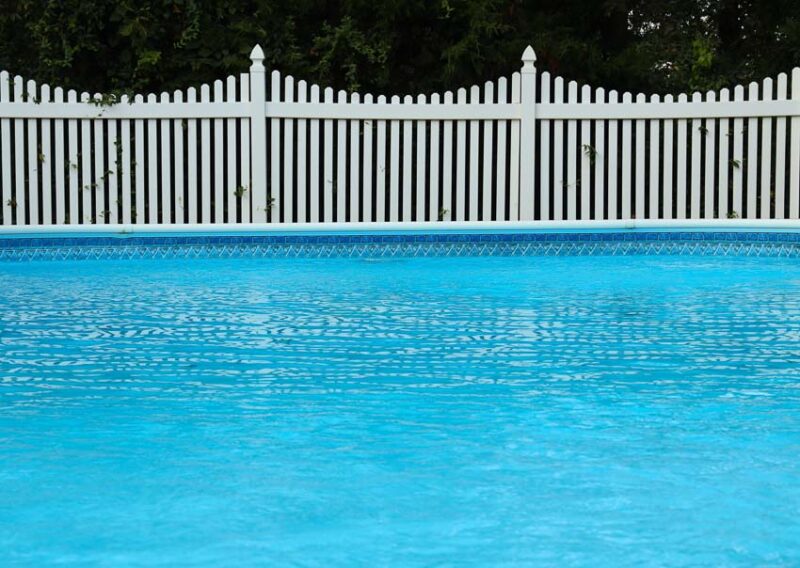
Planning for fences before doing anything else is important because the type of above ground pool fencing you choose will help determine other types of hardscaping features to incorporate into your landscaping.
Borders
Adding a border of river rock around your above ground pool is one of the simplest methods to integrate your pool with the rest of your landscaping. You can tie in the river rock border with a pathway that leads to your pool to help ease the transition.
While you should install your above ground pool on bare ground, you can also use pavers and bricks to create a patio surface around your pool.
Decking Around an Above Ground Pool
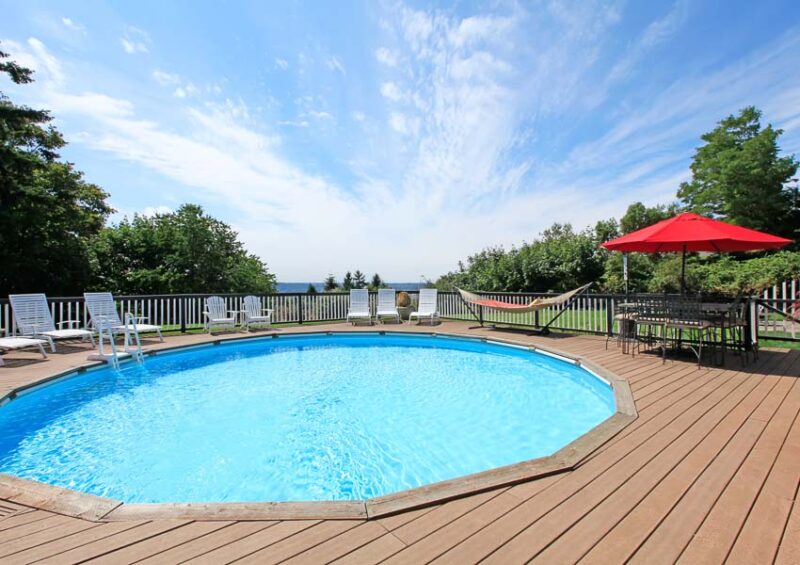
You can build decks for above ground pools from various materials.
They are usually about three to six feet off the ground and can either wrap around part of your pool or the entire circumference. As with any type of decking, they need a solid foundation.
Seating Ideas
Adding seating to your above ground pool landscaping will make your pool area more functional and luxurious. Here are some seating ideas to consider:
- Built-in seating
- Poolside bar table and stools
- Outdoor chaise lounges with storage for pool toys
- Poolside hammock
- Canopy daybed
Add poolside seating to your above ground pool landscaping in many ways. It will make it easier to entertain guests and enjoy pool time as a family.
Walls and Screens
Above ground pool exteriors aren’t visually appealing, so many people use walls that surround their pool. Choose from various materials to hide the exterior of your above ground pool so that it blends in better with the natural landscape.
- Wood slats
- Wall stone
- Decking material
- Bamboo screens
Lighting and Ambiance
To improve the atmosphere of your pool area, add lighting. Above ground pool lighting also makes your pool safer, and you have many options, including floating and string lights. You can also add lighting to your landscaping and hardscaping features, such as recessed lighting in an above ground pool deck.
Consider using a water feature in your poolside landscaping. Water features, especially water fountains, are focal points in any landscape and help create a relaxing atmosphere.
DIY or Hire: Landscaping Decision
One of the reasons many people choose above ground pools is because they are DIY friendly. You may also want to landscape around your pool if you’re an avid DIYer.
Pros and Cons of DIY Landscaping
There are several advantages to DIYing above ground pool landscaping, but depending on the scope of your project, you may need to consider important factors like cost and time.
Cost Savings and Personal Touch
DIY projects can save you a lot of money. DIY landscaping is a great way to stretch your budget and enhance the appearance of your poolside landscape.
Another benefit of DIY landscaping is that you can design your outdoor space however you want, and you’ll have the pride and satisfaction of successfully finishing a project.
Time and Expertise Considerations
DIY landscaping projects are labor intensive and often take longer than you think they will. Some projects take considerably longer, and your yard could be under construction for weeks if you try to do it alone.
Not all landscaping projects are DIY-friendly, and you may not possess the skill level or physical strength required for some jobs.
Benefits of Hiring a Landscaping Professional
Hiring a professional landscaper is a smart choice for extensive projects. They have the knowledge and expertise to do the job safely and correctly.
Professional landscapers have access to tools and equipment that many homeowners don’t. These include skid steers and backhoes, which they use to grade the soil around your pool or move heavy rocks into place.
Such machinery saves time and speeds up the construction process.
Hiring a professional is a great way to maximize the investment in your landscaping for complex projects like wraparound decking and stone walls that require expensive building materials.
Assessing Your Skill Level
Proper skill level assessment is the first consideration for any DIY project. Many DIYers have attempted a project that surpasses their skill level at some point, and while that’s a great way to learn, it can also lead to disaster.
As you develop your DIY skills, you become more confident. Until you’re certain about your DIY skill levels, choose simple projects with inexpensive materials. You can also hire a professional for the parts of the job that are outside your skill set.
FAQ: Common Questions About Landscaping Around an Above Ground Pool
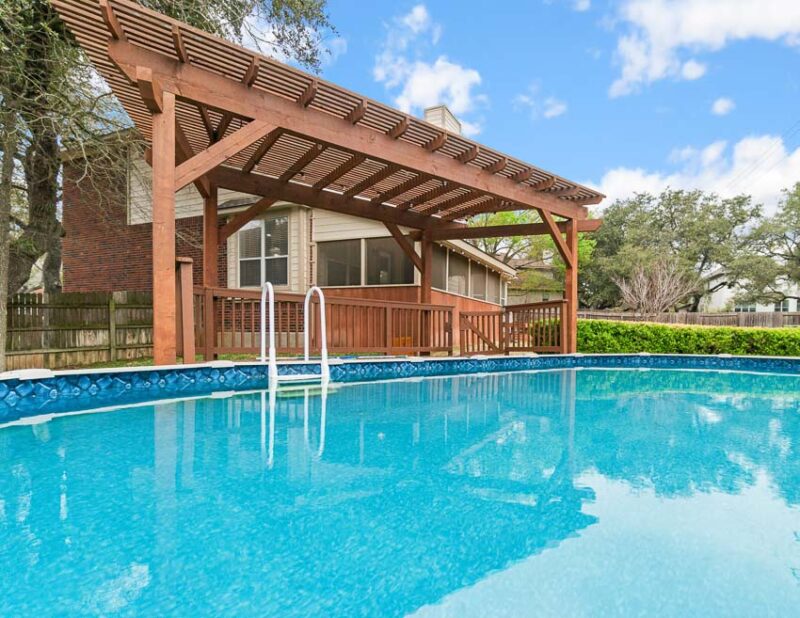
1. What type of plants work best around an above ground pool?
Evergreen plants are one of the most popular plants to use around above ground pools because they have low leaf litter. You can also choose ornamental grasses, which are hardy but don’t have extensive root systems that can damage your pool. Another excellent option is container gardening.
2. How can I ensure proper drainage around the pool area?
You must address several considerations to ensure proper drainage around your pool area. To start, don’t install your pool in a low spot; be sure to slope the ground away from the pool. About one-inch drop per foot is adequate to ensure proper drainage.
3. Can I install a deck or patio myself?
You can install a deck or patio with the right DIY skills and tools. Simple projects with straight lines are best for beginners, while more complex projects with circular lines and angles require more skill, time, and materials. Concrete patio paver installation is an excellent beginner DIY project.
4. How about low-maintenance landscaping options around my above ground pool?
There are several options for low-maintenance landscaping around an above ground pool. Artificial grass is the perfect choice because it won’t be affected by heavy foot traffic and will help keep your pool clean. Another great choice is a border of river rocks, which will stay in place and require little maintenance.
5. Will landscaping around my above ground pool increase the property value?
Landscaping is an excellent way to increase your home’s property value. Many property appraisers and realtors estimate that landscaping can add up to 20% to your home’s value. The return on investment (ROI) varies with different projects, but you can expect an average of about 150% ROI on the money you spend on landscaping.

